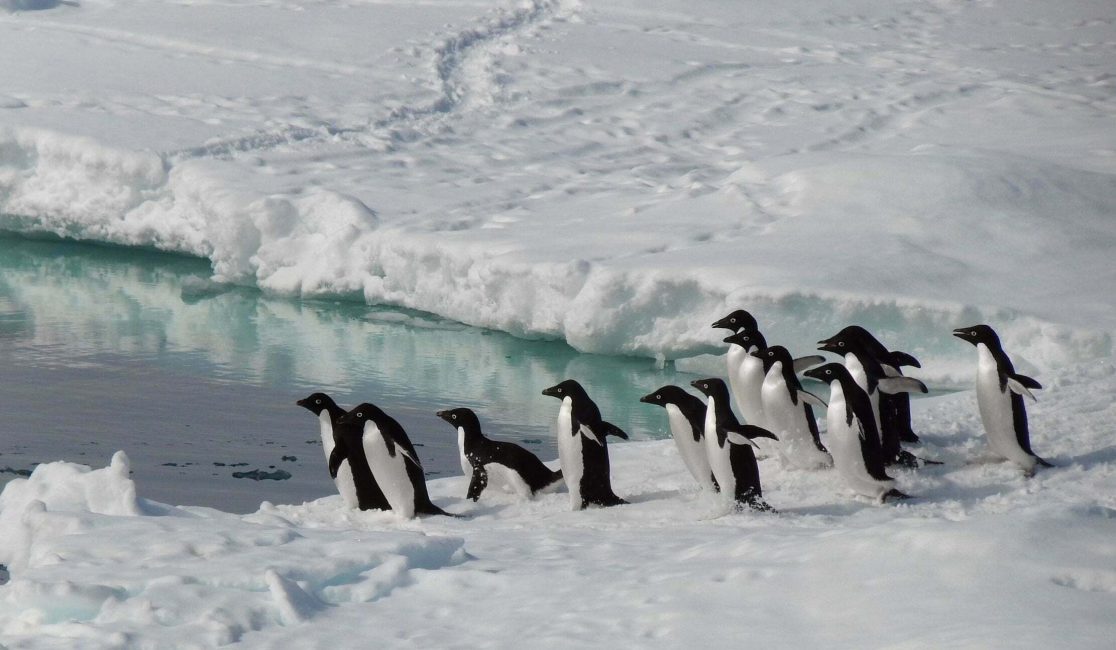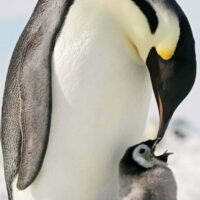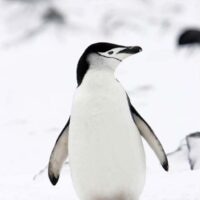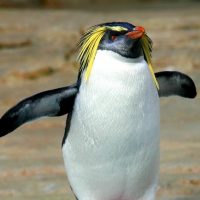Fast facts
ADÉLIE PENGUINS
Scientific name: Pygoscelis adeliae.
Height: 18–28 inches (46–71 centimeters).
Weight: 7.9 –13.2 pounds (3.6–6.0 kilograms).
Average lifespan in the wild: 10–20 years.
IUCN Red List status: Least concern, population increasing (2020).
Range
ADÉLIE PENGUINS
Adélie penguin colonies are found only in the Antarctic region, on the continent and nearby islands. Their largest populations are found in the Ross Sea area.
Each summer Adélie penguins form colonies on rocky outcrops to breed, raise their chicks and molt (replace their used feathers with new ones).
Identification
ADÉLIE PENGUINS
Adélie penguins are the smallest of the polar penguins. Hatchlings grow a cover of grey down, which they retain until their first molt reveals their adult plumage.
Adult Adélie penguins have a black face and black feathers that cover half of their bill. Their primary identifying feature is a white ring around their eye.
They have a black head, tail, and back, a white belly, and white or pink legs and feet.
Feeding
ADÉLIE PENGUINS
Antarctic krill (Euphausia superba) is the main food source for Adélie penguins, although they also eat fish, such as lantern fish and Antarctic silverfish (Pleuragramma antarcticum). Squid, other cephalopods, and amphipods are also part of their normal diet.
Like most seabirds, Adélie penguins store food and regurgitate it later to feed their newly hatched young.
Life cycle
ADÉLIE PENGUINS
Adélie penguins arrive at their breeding grounds in early spring. Males arrive before females, generally returning to their nest from the previous year. When females arrive they recognize their mate’s call and will often reunite with the same partner year after year.
Males are responsible for building a nest out of stones to provide shelter for their mate and future chick. Females lay two eggs (sometimes three) between October and November, and both parents take turns incubating the eggs for about 36 days.
Eggs hatch between December and January, and young chicks are dependent on their parents for security, warmth and food for about four weeks. The parents take turns caring for the chick and foraging for food, which they bring back to share with their rapidly growing offspring.
Chicks form creches
ADÉLIE PENGUINS
After about one month the chicks are ready to leave the security of the nest. They gather with other chicks in groups called creches, which provide a taste of independence with safety in numbers.
After 2 to 3 months the downy plumage of newborn chicks is replaced by adult plumage. They begin learning to swim in the shallows, to prepare for a life at sea.
When sea ice forms in the fall, most Adélie penguins migrate north to forage around the sea ice edge.
Predators
ADÉLIE PENGUINS
While foraging at sea, leopard seals are Adélie penguins’ main predators. Orca (killer whales) tend to target larger penguins, but do occasionally take Adélie penguins. The penguins have distinctive black and white plumage, which provides a form of camouflage against the sea or sky called countershading. This offers some protection from marine predators. They also porpoise while swimming, breaking through the surface of the water much like dolphins. This motion may be used to build up speed or confuse predators.
Southern giant petrels, skuas, and snowy sheathbills patrol Adélie penguin colonies in search of unguarded eggs, solitary chicks, and injured or sick adult penguins. Adélie penguins defend themselves vigorously from these aerial attacks, vocalizing and slapping predators with their rigid flippers to deter them.
ASOC recommends:
Adélie penguins are vulnerable to a warming climate. Although their population across much of Antarctica is robust, many Adélie penguin colonies on the Antarctic Peninsula have declined by up to 80 percent since the 1970s. Find out why.
Protecting Adélie penguins
ADÉLIE PENGUINS
ADÉLIE PENGUINS
Related reading
Now that you’ve learned about Adélie penguins, read on to discover more about extraordinary Antarctica.
 ASOC
ASOC
















